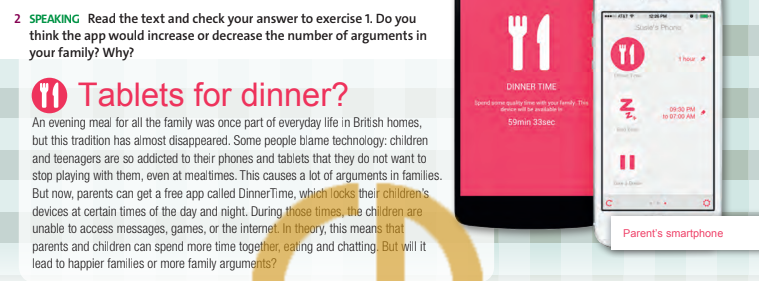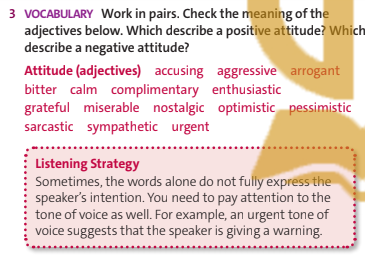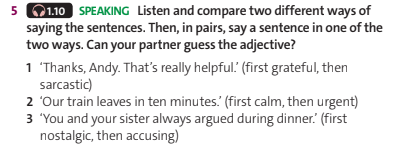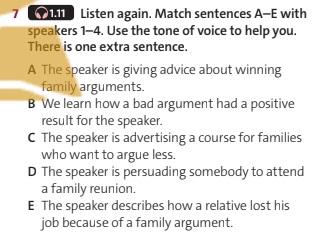Tiếng Anh 11 Friends Global Unit 1 1C Listening
Giải Tiếng Anh 11 Friends Global Unit 1 trang 15
Giải bài tập SGK tiếng Anh 11 Friends Global Unit 1 1C Listening trang 15 hướng dẫn giải chi tiết các phần bài tập trong Sách giáo khoa tiếng Anh lớp 11 Friends Global giúp các em học sinh chuẩn bị bài tập tại nhà hiệu quả.
Tiếng Anh 11 Friends Global Unit 1 1C Listening
Bản quyền thuộc về VnDoc nghiêm cấm mọi hành vi sao chép vì mục đích thương mại
1. SPEAKING Work in pairs. Look at the photo. What do you think this app does? Why might some people need it?
(Làm việc theo cặp. Nhìn vào bức hình. Bạn nghĩ ứng dụng này làm gì? Tại sao một số người có thể cần nó?)
Gợi ý đáp án
I think this app relates to mealtimes. I can see the kid's smartphone and parent’s smartphone. This app may prevent children from using devices while eating breakfast, lunch or dinner. In my opinion, some people, especially some parents, need it because nowadays, children always glue their eyes to the screen all the time, even when they are eating. Therefore, most parents use this app to help their kids have quality time when they are having meals.
(Tôi nghĩ rằng ứng dụng này liên quan đến giờ ăn. Tôi có thể thấy điện thoại thông minh của trẻ em và điện thoại thông minh của cha mẹ. Ứng dụng này có thể ngăn trẻ em sử dụng các thiết bị trong khi ăn sáng, ăn trưa hoặc ăn tối. Theo tôi, một số người, nhất là một số phụ huynh cần vì hiện nay trẻ em lúc nào cũng dán mắt vào màn hình, kể cả khi đang ăn. Do đó, hầu hết các bậc cha mẹ sử dụng ứng dụng này để giúp con cái họ có thời gian chất lượng khi dùng bữa.)
2. SPEAKING Read the text and check your answer to exercise 1. Do you think the app would increase or decrease the number of arguments in your family? Why?
(Đọc văn bản và kiểm tra câu trả lời của bạn cho bài tập 1. Bạn nghĩ ứng dụng này sẽ làm tăng hay giảm số lần cãi vã trong gia đình bạn? Tại sao?)

Gợi ý đáp án
I think the app would decrease the number of arguments in your family. At first, this can cause a lot of arguments because the children aren't used to using no devices while eating. However, after one or two weeks, the children can have a new healthy habit without smartphones or tablets during mealtimes. After that, they will feel free to share everything with their family and like to have good moments when the family are eating together. Therefore, everyone can understand each other more clearly, enjoying quality time and even the number of arguments would decrease.
(Tôi nghĩ ứng dụng này sẽ giảm thiểu tình trạng cãi vã trong gia đình bạn. Ban đầu, điều này có thể gây ra nhiều tranh cãi vì trẻ chưa quen với việc không sử dụng thiết bị điện tử trong bữa ăn. Tuy nhiên, sau một hoặc hai tuần, trẻ sẽ hình thành thói quen lành mạnh mới mà không cần điện thoại thông minh hay máy tính bảng trong bữa ăn. Sau đó, trẻ sẽ thoải mái chia sẻ mọi thứ với gia đình và tận hưởng những khoảnh khắc vui vẻ khi cả nhà dùng bữa cùng nhau. Nhờ đó, mọi người có thể hiểu nhau hơn, tận hưởng những khoảng thời gian chất lượng và thậm chí số lượng tranh cãi cũng sẽ giảm đi.)
3. VOCABULARY Work In pairs. Check the meaning of the adjectives below. Which describe a positive attitude? Which describe a negative attitude?
(Làm việc theo cặp. Kiểm tra ý nghĩa của các tính từ dưới đây. Cái nào mô tả một thái độ tích cực? Cái nào mô tả một thái độ tiêu cực?)

Gợi ý đáp án
- Adjectives describe negative attitude: aggressive, arrogant, miserable, nostalgic, - pessimistic, sarcastic, urgent, bitter
- Adjectives describe positive attitude: calm, complimentary, enthusiastic, optimistic, sympathetic, grateful
4. Read the Listening Strategy. Then listen and underline the adjective which best matches the speaker's attitude. Use their tone of voice to help you.
(Đọc Chiến lược nghe. Sau đó lắng nghe và gạch dưới tính từ phù hợp nhất với thái độ của người nói. Sử dụng giọng điệu của họ để giúp bạn.)

Gợi ý đáp án
|
1. pessimistic |
2. aggressive |
3. complimentary |
4. sympathetic |
Nội dung bài nghe
Speaker 1: We’ve got a big family dinner tonight. I expect there’ll be an argument. There usually is. That’s why I hate these dinners. They always end badly.
Speaker 2: Hey! Get out of my chair! I want to sit there. I can’t see the TV if I sit on this side of the table, can I? Come on, hurry up!
Speaker 3: You’re looking well. Is that a new shirt? It’s very nice. I love the colour - it really suits you.
Speaker 4: I’m so sorry you didn’t pass your test. You must be very disappointed. But don’t worry, you can take it again next month - and I’m sure you’ll pass it then.
5. SPEAKING Listen and compare two different ways of saying the sentences. Then, in pairs, say a sentence in one of the two ways. Can your partner guess the adjective?
(Nghe và so sánh hai cách nói khác nhau của câu. Sau đó, theo cặp, nói một câu theo một trong hai cách. Bạn của bạn có thể đoán tính từ không?)

6. Work in pairs. Listen to four speakers and decide which speaker sounds:
(Làm việc theo cặp. Nghe bốn người nói và quyết định người nói nào nào nghe có vẻ)

7. Listen again. Match sentences A-E with speakers 1-4. Use the tone of voice to help you. There is one extra sentence.
(Lắng nghe một lần nữa. Ghép câu A-E với người nói từ 1-4. Sử dụng tông giọng nói để giúp bạn. Có một câu bị thừa.)

8. SPEAKING Work in pairs. Decide which of these topics is most likely to cause arguments in your family and why. Are there any others you can think of? Compare your ideas with the class.
(Làm việc theo cặp. Quyết định chủ đề nào trong số những chủ đề này có nhiều khả năng gây ra tranh cãi trong gia đình bạn nhất và tại sao. Bạn có thể nghĩ ra thêm những cái khác không? So sánh ý tưởng của bạn với lớp học.)

Gợi ý đáp án
- In my opinion, too much time spent on social media and games is the most likely to cause arguments in the family. For example, I have one younger brother, he is 14 years old, and he really likes playing on his smartphone. He can spend all of his free time using smartphone for entertainment and games. As a result, he ignores his studying and my mom and my dad have to force him to study a lot but he doesn't like it. This makes my parents angry and unsatisfied. They always shout at my brother, and he is becoming more and more aggressive. Therefore, my family always has an argument about this problem.
- Some topics that cause arguments in families that I can think of are: what to see on TV, where to hang out, what kind of household appliance to buy, how to use money…
Xem tiếp: Unit 1 tiếng Anh lớp 11 Friends Global trang 16 MỚI
Trên đây là Unit 1 tiếng Anh lớp 11 Friends Global trang 15 đầy đủ nhất.








